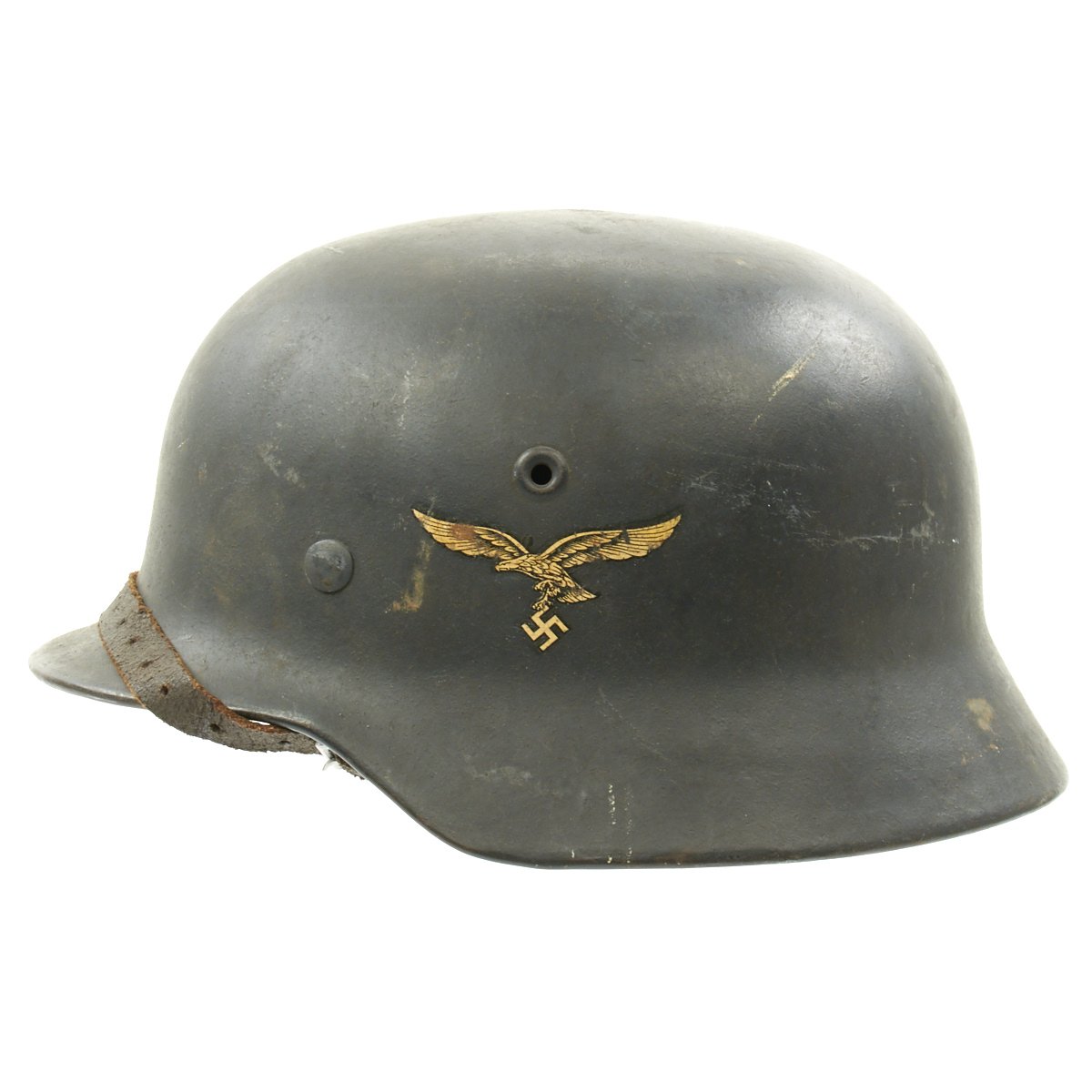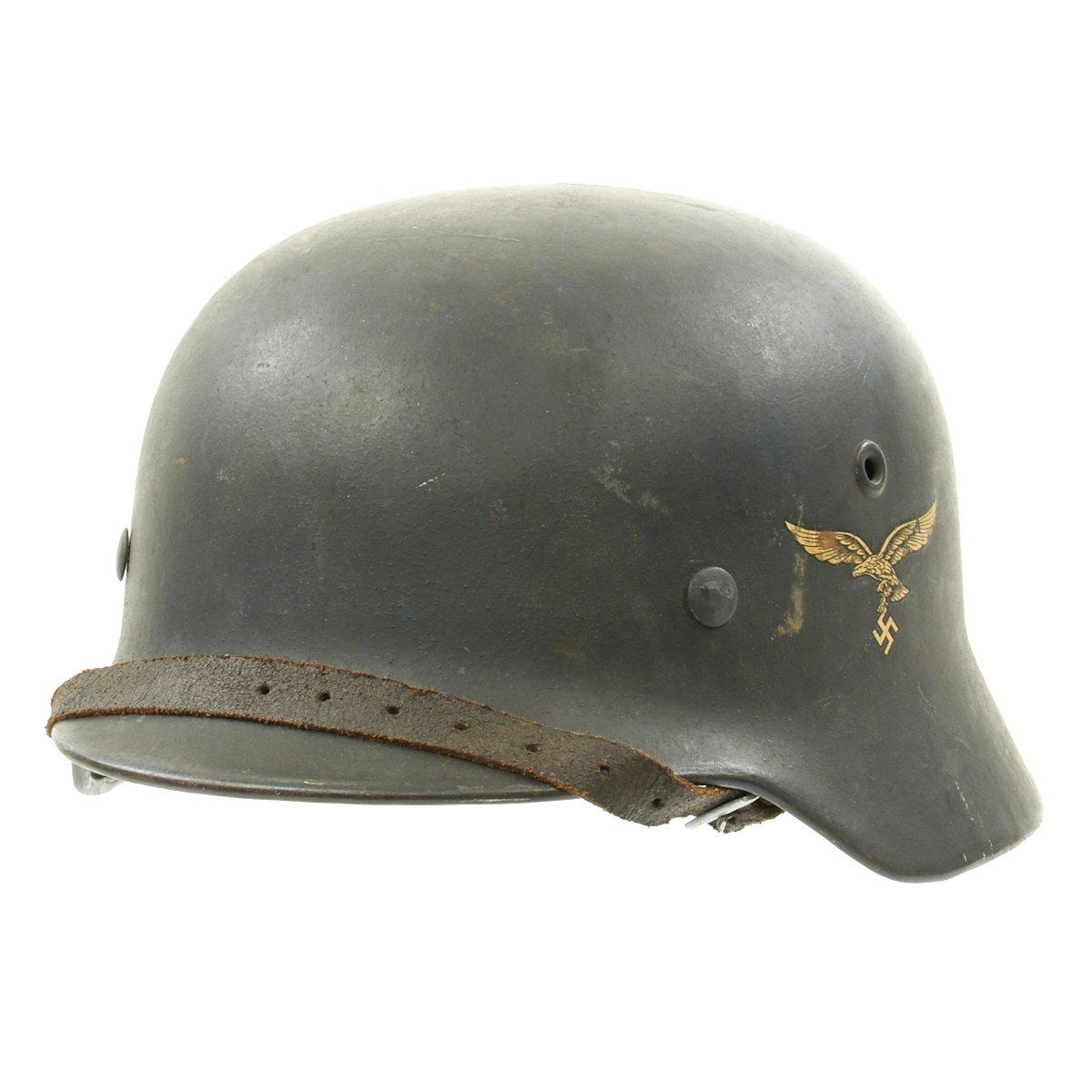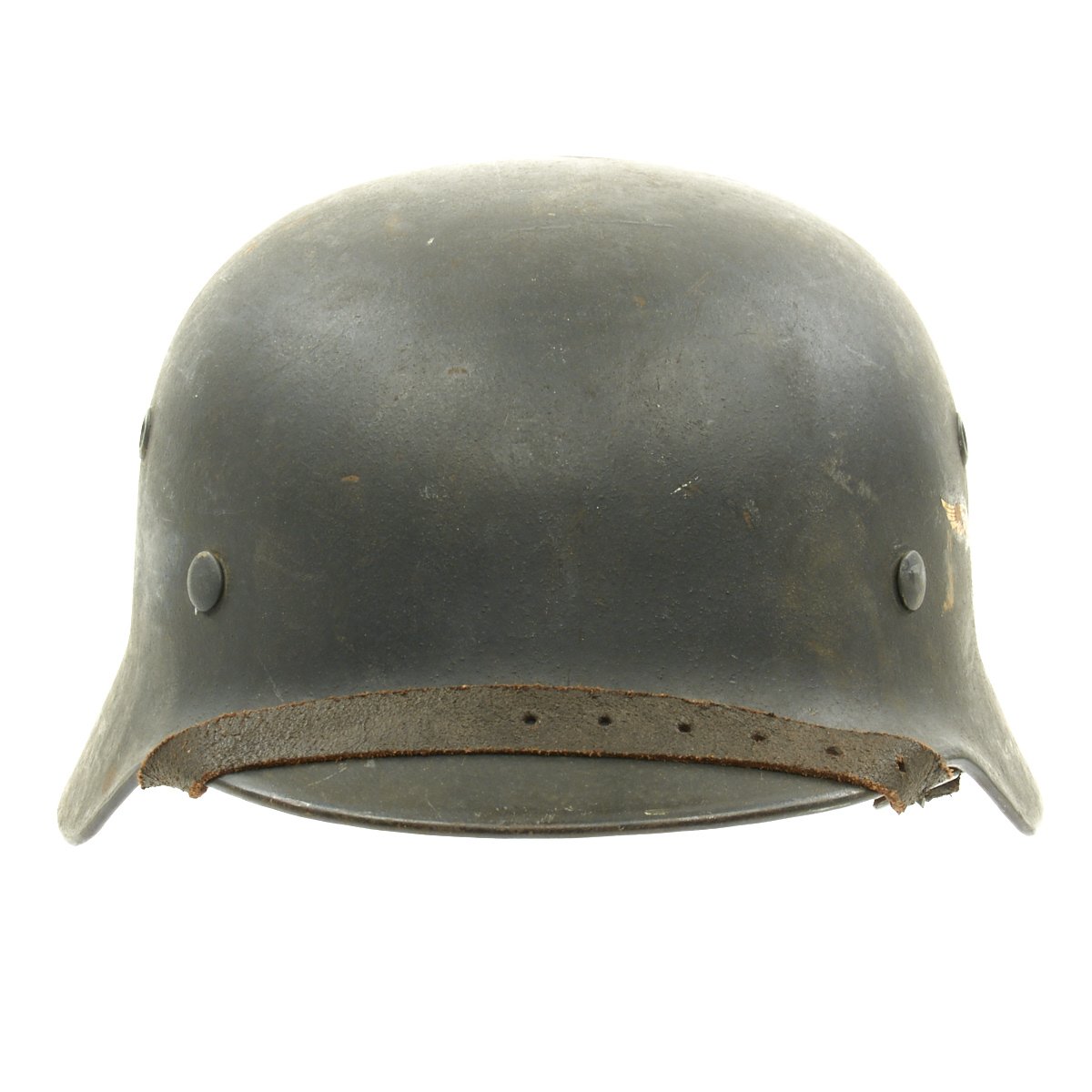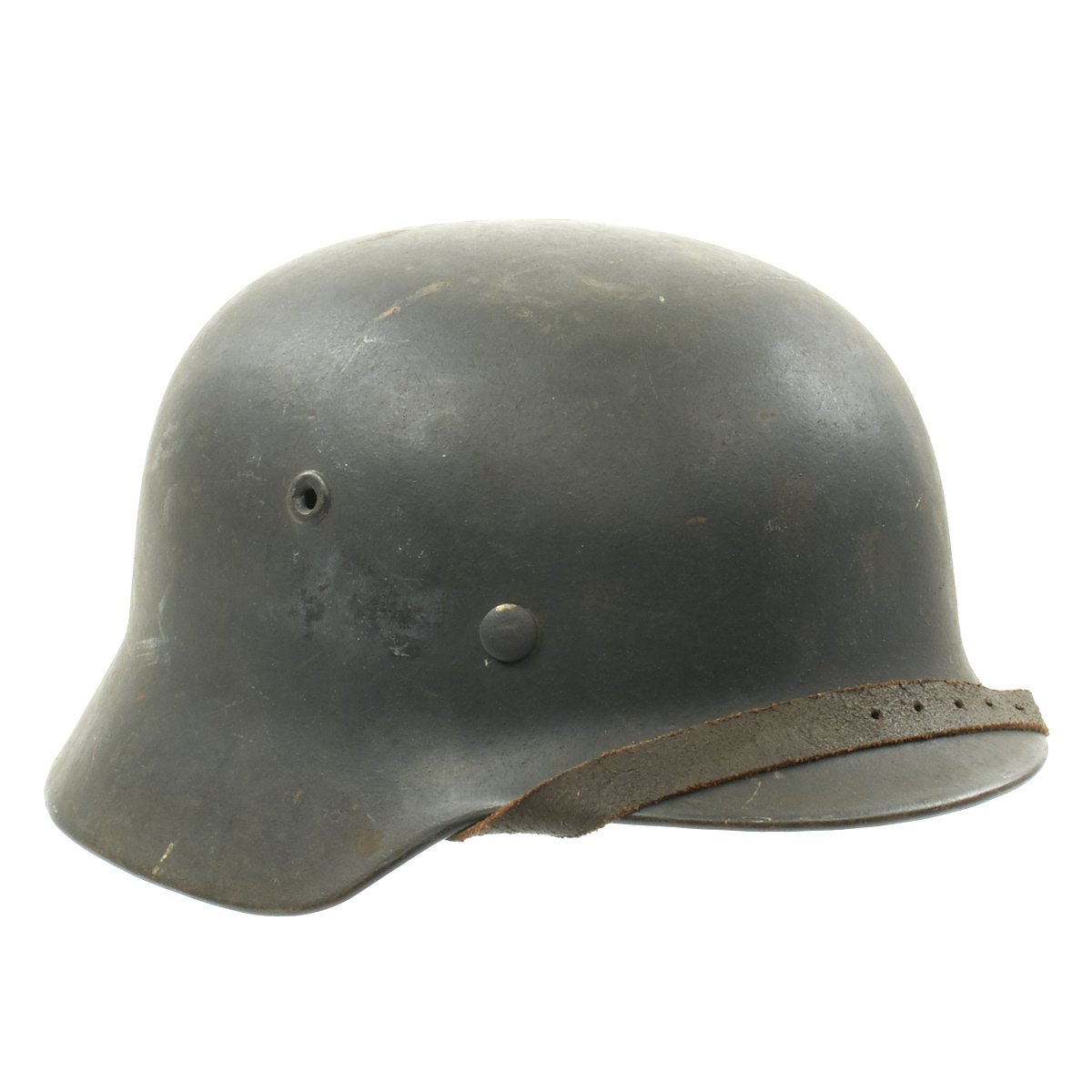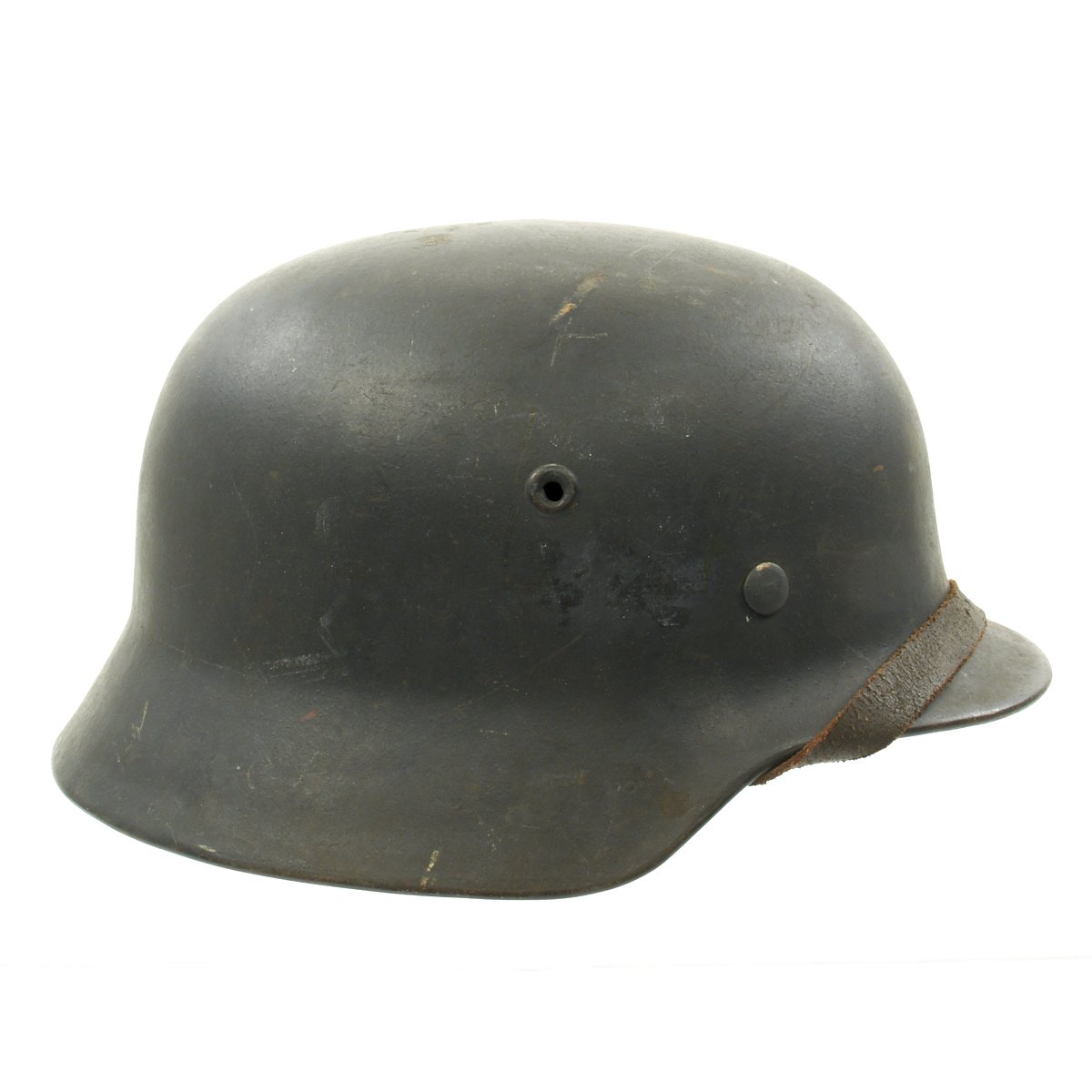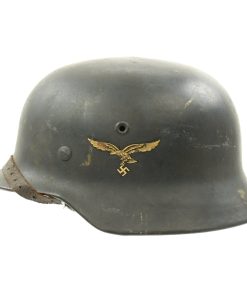Original German WWII M40 Single Decal Luftwaffe Helmet with Size 61cm Liner Captured in Italy – ET68 Original Items
$ 950,00 $ 237,50
Original Item: Only One Available. This is an excellent all original example of a Model 1940 German WW2 helmet, with a single Luftwaffe Eagle decal. This stamped sheet steel construction helmet retains over 95% of the original blue/grey lightly textured Luftwaffe paint and is in excellent condition overall. The decal is retained at 90%, with a rust spot on one of the wings. This is one of the best helmets of this type that we have seen.
On the reverse of the shell’s interior, the neck guard apron is lot number stamped, 468 and has a stamped manufacturer’s code over the left ear and size, ET68 indicating it was manufactured by Eisenhuttenwerk AG, Thale Harz. Size 68 is a nice extra large size that can accommodate liners from 60cm to 61cm or US 7 1/2 to 7 5/8.
All three original liner retaining pins are intact and have complete original paint on the ends. The interior of the helmet still has an original very good M31 leather liner with all eight fingers mostly present and still supple, though the tip has pulled off of one, which is also somewhat cracked. There is a faint size 61 stamp on one finger. The chin strap is complete, and in very good condition, with a maker mark of R. LARSEN / BERLIN / 1939 stamped on the end. The leather is soft and supple, though it definitely has some wear.
The most interesting part about this helmet is the markings on the liner and included letter. The liner has June 45 as well as Tillman 3534 written in pen on the interior. We also have a short note, written by Glenn Oehring, who the helmet was acquired from. It indicates that the helmet was captured in the Poe Valley in Italy, on or about June 1945. Definitely a good opportunity for further research!
Overall an excellent condition genuine M40 Single Decal Luftwaffe helmet with nice provenance! This is an item that will only continue to appreciate in value over time.
The first “modern” steel helmets were introduced by the French army in early 1915 and were shortly followed by the British army later that year. With plans on the drawing board, experimental helmets in the field, (“Gaede” helmet), and some captured French and British helmets the German army began tests for their own steel helmet at the Kummersdorf Proving Grounds in November, and in the field in December 1915. An acceptable pattern was developed and approved and production began at Eisen-und Hüttenwerke, AG Thale/Harz, (Iron and Foundry Works), in the spring of 1916.
These first modern M16 helmets evolved into the M18 helmets by the end of WWI. The M16 and M18 helmets remained in usage through-out the Weimar Reichswehr, (National Defence Force, Circa 1919-1933), era and on into the early years of the Third Reich until the development of the smaller, lighter M35 style helmet in June 1935.
In 1934 tests began on an improved Stahlhelm, whose design was a development of World War I models. The Eisenhüttenwerke company of Thale carried out prototype design and testing, with Dr. Friedrich Schwerd once again taking a hand.
The new helmet was pressed from sheets of molybdenum steel in several stages. The size of the flared visor and skirt was reduced, and the large projecting lugs for the obsolete armor shield were eliminated. The ventilator holes were retained, but were set in smaller hollow rivets mounted to the helmet’s shell. The edges of the shell were rolled over, creating a smooth edge along the helmet. Finally, a completely new leather suspension, or liner, was incorporated that greatly improved the helmet’s safety, adjustability, and comfort for each wearer. These improvements made the new M1935 helmet lighter, more compact, and more comfortable to wear than the previous designs.
The Army’s Supreme Command officially accepted the new helmet on June 25, 1935 and it was intended to replace all other helmets in service.
More than 1 million M1935 helmets were manufactured in the first two years after its introduction, and millions more were produced until 1940 when the basic design and production methods were changed. This mainly involved adding the vent hole to the stamping process, as opposed to adding the rivet later.
Fast Shipping with Professional Packaging
Thanks to our longstanding association with UPS FedEx DHL, and other major international carriers, we are able to provide a range of shipping options. Our warehouse staff is expertly trained and will wrap your products according to our exact and precise specifications. Prior to shipping, your goods will be thoroughly examined and securely secured. We ship to thousands clients each day across multiple countries. This shows how we're dedicated to be the largest retailer on the internet. Warehouses and distribution centres can be located throughout Europe as well as the USA.
Note: Orders with more than one item will be assigned a processing date depending on the item.
Before shipping before shipping, we'll conduct a thorough inspection of the items you have ordered. Today, the majority of orders will be delivered within 48 hours. The delivery time will be between 3-7 days.
Returns
The stock is dynamic and we cannot completely manage it because multiple stakeholders are involved, including our factory and warehouse. So the actual stock may alter at any time. It's possible that you may not receive your order once the order has been made.
Our policy is valid for a period of 30 days. If you don't receive the product within 30 days, we are not able to issue a refund or an exchange.
You can only return an item if it is unused and in the same state as the day you received it. You must have the item in its original packaging.
Related products
Uncategorized
Uncategorized
Uncategorized
Uncategorized
Uncategorized
Uncategorized
Australian WWII Owen MK1 Machine Carbine SMG Custom Fabricated Replica with Sling Original Items
Uncategorized
Uncategorized
Uncategorized
Band of Brothers ORIGINAL GERMAN WWII Le. F.H. 18 10.5cm ARTILLERY PIECE Original Items
Uncategorized
Uncategorized
Uncategorized
Uncategorized
Armored Burgonet Helmet & Polearm from Scottish Castle Leith Hall Circa 1700 Original Items
Uncategorized
Uncategorized
Uncategorized
